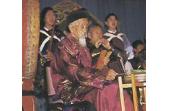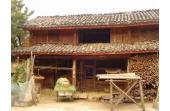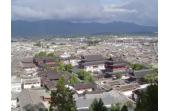Lijiang
- Things to do
-
- Photo(130)
- Tips&article(122)
- Make it Happen
- Map
-
loading...
Top 5 Lists
Overview
Northwestern Yunnan Province near Tibet has become popular as a hiking area with spectacular natural scenery and accommodations available at a variety of hostels, hotels, and inns. There are interesting historical sites dating back hundreds of years interspersed with high mountains, forests, wild rivers and streams. The Yangtze River passes through this area, and Tiger Leaping Gorge of the Yangtze is a beautiful sight as are the Yulong (Jade Dragon) Snow Mountains. The Yulong Snow Mountains has a small ski area for beginners that is useable when the weather is good. It is Yunnan’s only ski area. The cultural and historical attractions in Lijiang County are the Naxi towns and the ancient districts of the city of Lijiang. Three ancient districts of the city of Lijiang became a UNESCO World Heritage area in 1997. Some parts of Lijiang are listed as a UNESCO Three Parallel Rivers Protected Reserve Area and are nature preserves, and for the variety of outdoor hiking, scenic areas, the ski area and interesting cultural and historical sites, it is worth visiting.
Detailed Descriptions
Lijiang is both the name of the city and of the county. It is about 150 kilometers from Burma and about 200 kilometers from Tibet. Most of the county is sparsely populated with nature preserves, high mountains, small towns, farms, and the shepherds’ pastures. The whole county of Lijiang has about 1.2 million people in area of about 21,200 square kilometers. The city of Lijiang has about a half million people.
In 1997, three ancient districts of the Lijiang urban area were included on the UNESCO World Heritage List because they are in a dramatic landscape where the Han and Naxi cultures blended to “produce an urban landscape of outstanding quality.” The UNESCO description says that Lijiang was a key commercial and strategic site and that the “architecture is noteworthy for the blending of elements from several cultures that have come together over many centuries.
” They also noted that “Lijiang also possesses an ancient water-supply system of great complexity and ingenuity that still functions effectively today.”
The three districts that are included in the Heritage List are the central Dayan District that is also called the Ancient City (古城) District, Shuhe Town that is 7 kilometers north-northwest of the Ancient City District, and Baisha Quarter that is about 5 kilometers north of Shuhe Town. The Dayan Ancient City District, Shuhe Town, and Baisha Quarter are the main historical highlights of Lijiang.
There are plenty of places for tourists to stay and eat in Lijiang. Next to the Dayan Ancient City District, the modern Nanmen area has been built with restaurants, shops, hotels and amusements places. Next to the Shuhe Town area, the Chama Tourist Center district was also recently built with similar kinds of businesses. After UNESCO listed Lijiang as a special historical city, the number of tourists greatly increased, and people came to build hotels, shops and restaurants for tourists.
There are natural scenic places in the city and close to it that are worth visiting. There are two small parks. Next to the Dayan Ancient City District is Yuquan Park that includes part of a hill overlooking the city and Black Dragon Pool. The hill and the Black Dragon Pool (Heilongtan) area have old temples you can see.
You can also see a beautiful view of the Yulong Snow Mountains from the park area. Next to Shuhe Ancient Town is another small park called World Yichan Park. It doesn’t have a hill. Those would be places to go any time of the year while strolling around in the ancient districts.
Yulong (Jade Dragon) Snow Mountains are tall peaks near Lijiang. The southern part of these mountains are about 30 kilometers north of the Ancient City District and only about 20 kilometers north of the Baisha quarter. The Yulong Snow Mountain ski area is a popular place for local people in the area to go to in the winter.
Few Chinese ski, but people like to go there to play in the snow. It has a beginner’s ski field about a half kilometer long that is useful when the weather is right in the winter. But it is only good for a day trip. It isn’t a resort. There are glaciers on those peaks that are the southernmost in the world.
In the summer, late spring and early fall, the Yulong Snow Mountains are a place to hike and enjoy the scenery and the natural forest. The tallest peak of the mountains is called Shanzidou (扇子陡), and it has an elevation of 5,596 meters or 18,360 feet. This is very tall. The Rocky Mountains in America don’t go higher than 14,500 feet, and the highest peak in the Alps in Europe is about 15,800 feet.
Only two people, both Americans, have ever climbed the mountain. They said it is extremely dangerous. One of the smaller peaks has an elevation of about 4,680 meters or 15,354 feet, and a specially constructed stairway and path goes up to the summit of that peak (but not the very tip) so that people can climb safely.
People say the view from that high peak is spectacular. The Yangtze River flows in the valley below the mountain, and there are many waterfalls and rapids. Leaping Tiger Gorge of the Yangtze is one of the famous places of mountains.
Lijiang is about 400 kilometers northwest of Kunming and is easily accessible by plane or coach. Though there has been much new construction and commercialization, the ancient districts in the city and the natural scenery nearby still retain much of the special character that people thought made the districts worth including in the Heritage List. The city of Lijiang is the gateway to many other tourist attractions in the region including Jade Dragon Snow Mountain with its ski resort, the First Bend of the Yangtze River, and Tiger Leaping Gorge.
History
The town was built during the end of the Southern Song (1127-1279) and the beginning of the Yuan Dynasty (1279-1368) at the place where the Jade River breaks into three branches. The town was built at a stop on the “Chama” Tea-Horse Road that runs up from Dali in the south and then down from Dali to the Puer Tea growing region that grows a highly priced and popular tea. The people in Tibet traded horses for tea from Yunnan, and the town was a stopping place near the high mountains of Tibet.
People say that perhaps the Naxi settlers were driven south by the Mongol tribesmen who conquered China. The Mongols founded the Yuan Dynasty. Many ethnic groups have passed through including the Tibetans, the Hans, and the Bais (the people in the Dali area). During the early years of the Yuan Dynasty, about 1,000 families inhabited Lijiang Ancient Town. The town continued to grow, and it reached a peak during the Ming (AD 1368-1644) and Qing (AD 1644-1911) Dynasties.
The ancient town was founded at a place where the Jade River divides into three. The people took advantage of the river and the streams to build a complex water system that people liken to the canal system of Venice. The river flows from the north of the town, divides into 3 tributaries, and then divides into many streams that flow through courtyards and past houses in a southerly direction. The streams are channeled into ponds or basins for use. This water system was one of the special and important features of the town mentioned in the UNESCO World Heritage List description.
The construction of railroads and the invention of propeller-driven ships took the place of traders with horses, mules and yaks plodding along in the valleys. So the trade on the “Chama Road” paths through the area was significantly reduced in the early 20th century until the Japanese attacked in the late 1930s. Suddenly, caravan trade became very important militarily and commercially since the ocean routes became a theater for war and the Japanese controlled the coastal areas. At the end of WWII and after the Communist government blocked trade with other countries, the trading ended.
In 1996, there was a big earthquake of magnitude 7.0 on the Richter Scale. About 250 people died in the first earthquake, and afterwards there were mudslides and more aftershocks in which more people died. Many of the more modern structures were damaged, but people say that the traditional style houses proved to be remarkably earthquake resistant.
This earthquake may have been key for UNESCO’s recognition of Lijiang in the World Heritage List in 1997 because the earthquake put the small city on the attention of people around the world and because many more modern apartment buildings and other modern buildings were torn down, and the government replaced them with more traditional-looking houses.
They also rebuilt, renovated and restored some of the old bridges and canals. So the area looked more like ancient Lijiang after the earthquake than before.
According to a recent report prepared for UNESCO, about 65 percent of the people presently living in Lijiang are Naxi people. However, after the listing of the three Lijiang districts on the Heritage List in 1997, the flood of tourists also brought many people from other areas of China who constructed new businesses to accommodate them.
This drove up prices in the area, and many Naxi and other local people moved away. Of the three areas listed as Heritage Sites, the Baisha Quarter about 10 or 11 kilometers north of the Dayan Ancient City District is less commercialized and has had less modern construction in the area. So if you want to experience more of the special traditional feel that the UNESCO committee described in 1997, that is the place to go.
In the 1990s, Lijiang County was known primarily as a backpackers’ area for foreign tourists with Naxi villages and ancient towns. The Lijiang urban area has grown into a city of about half a million people, and the whole area has become popular with Chinese tourists. Tiger Leaping Gorge has become especially popular. Now about half a million foreign tourists and more than five million Chinese tourists visit Lijiang County each year.
Location
Northwestern Yunnan Province. It is about 180 kilometers north of Dali. This is about 3 hours on the highway.
Features
- Old Naxi architecture and special water system.
- About a half hour away from Jade Dragon Snow Mountain with several scenic park areas, some hiking trails and a 4,680 meter (15,354) foot peak you can climb up on a stairway past a glacier.
- Leaping Tiger Gorge area with hiking and scenic sights. If the road is open, there are many tour buses available.
- Other scenic and hiking areas including the First Bend of the Yangtze River and Lugu Lake.
- High-protein dairy and yak beef and lamb cuisine including Naxi sandwiches with eggs, cheese and tomato, yoghurt, yoghurt-fruit-honey blends, yak steak, yak milk, and yak butter. Naxi beverages include various kinds of tea such as yak milk tea and traditional beer.
Touring Activities
- Visiting the ancient districts, shopping and dining.
- High country walks and scenery. Hiking above the Yangtze River.
- Take a bus tour in the Leaping Tiger Gorge area.
- Enjoy Naxi cuisine.
- Go to other nearby areas such as Dali that is 3 hours south or natural sites in the Three Parallel River UNESCO Heritage Site region. The Leaping Tiger Gorge area is one of the UNESCO listed sites.
Tips & articles
|
|
|
forum discussion
|
|
|












